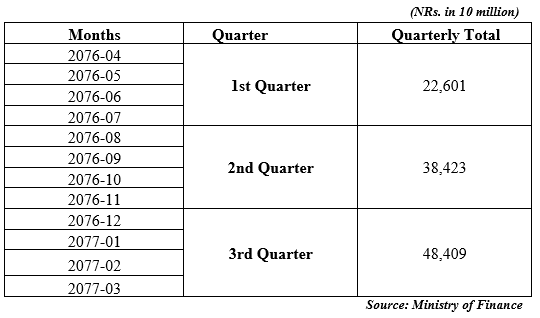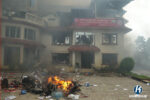Every year, the government scrambles to spend the annual budget before the next budget comes into execution. In Nepal, it is widely termed as “Asaray Bikash” that implies to the Nepali month of Asar (June-July) when the government authorities flap their wings to spend the budget at the eleventh hour.
In Nepal, capital expenditure has been a recurrent problem as the government toils hard to spend the budget amid public criticism. The government then has a usual response: This will not happen next fiscal year. Unfortunately, the custom is repeated!
What is budget data?
Budget data is defined as data relating to the broad funding priorities set forth by a government, often highly aggregated or grouped by goals at a particular agency or ministry.
For example, the Government of Nepal allocated Rs 8.93 billion in funding for the Kathmandu-Terai Fast Track for the current fiscal year, which is half the amount than the last two FY. The government aims to complete the project within the next three years.
However, the government has still some lame-excuses such as obstruction from the locals, among others. This is evident that the government is not serious towards spending the allocated budget within the stipulated timeframe.
What is a budget?
A government budget is basically an annual financial statement or a total estimation of revenue and expenditure that a country has targeted to achieve over a fiscal year.
It is generally compiled, re-evaluated and revised periodically. Basically, a country develops the budget as a principal tool in future planning of programs and activities, highlighting priorities, managing on-going programs, and developing control and accountability.
It, in fact, outlines the estimated government expenditure and expected government revenues or receipts for the forthcoming fiscal year.
Budgets basically are of three types — balanced budget, surplus budget and deficit budget, depending on the feasibility of the estimates.
Government Budget of Nepal
Looking at a country’s budget expenditure, it is separated into capital expenditure and recurrent expenditure.
While the capital expenditure is used for development works or infrastructure such as building schools or hospitals and to acquire, upgrade, and maintain physical assets such as property, plants, buildings, technology, or equipment, recurrent expenditure is all other payments such as wages, salaries and supplements, purchases of goods and services and consumption of fixed capital (depreciation).
Now while discussing the implementation of the budget, as soon as the government announces a budget of the country, the allocated amount for respective plans and programs for the Fiscal Year (FY) needs to be initiated by related government organizations.
In Nepal, we generally hear about the budget not being used and utilized on time which, indeed, is true. The following data shows the monthly expenditure of the Government of Nepal from FY 2076/77.
Table 1: Monthly Government Expenditure of FY 2076/77


The data shows that in FY 2076/77, NRs. 4 arab 29 crore was spent by the government in the month of Shrawan whereas a total of 2 kharab 11 arab 56 crore was spent in the month of Asar.
If the data is to be analyzed, voices raised concerning the government expenditure being least at the initial months and hiking during the final months of the FY seems to be true. Here, let us have a cursory look at the reasons.
The Government of Nepal divides Fiscal year into 3 quarters with each quarter consisting of 4 months. To be precise, the first 4 months i.e. Shrawan, Bhadra, Ashoj and Kartik fall under the first quarter whereas, Mangsir, Poush, Magh and Falgun come under the second quarter and rest fall under the third quarter.
The budget spending specifically depends on the plans and programs of the government. If the number of programs and activities is more in the 1st quarter then the expenditure increases in the said quarter and vice versa.
In Nepal, most of the plans and programs are scheduled for the 2nd and 3rd quarters of the FY which is one of the reasons for the increase in expenditure during the end of the FY.
In the FY 2076/77, a total of 2 kharab 26 arab 1 crore was spent in the 1st quarter whereas 3 kharab 84 arab 23 crore was spent in the 2nd quarter and a total of 4 kharab 84 arab 9 crore was spent in the 3rd quarter.
Table 2: Quarterly Government Expenditure of FY 2076/77


Usually, in the month of Shrawan, the government bodies remain busy in closing the previous year’s plans and policies and making preparation for ongoing FY’s plans and programs.
Concerned officials spent most of the time of the 1st quarter on planning and accelerating efforts for the upcoming plans and programs.
Alongside, Dashain and Tihar – the two major festivals of Nepalis — fall under the 1st quarter because of which officials do not get ample time to work due to official holidays of at least 10 days.
Moreover, the majority of the people go back to their home districts by taking additional leave of two to three days.
During this period, the government merely call for tender and puts forward the plans and programs. Hence, this might be one of the reasons for the low expenditure in the 1st quarter.
The Public Procurement Plan is another reason for the delay in budget expenditure. As per this plan, a government body needs to place an advertisement of maximum 30 days depending on different thresholds of the transactions while conducting a tender.
After 30 days, an additional 7-day-period is allocated to select a company/vendor and the next 7 days is allocated for others to file complaints against the respective government body. This means that the entire process takes at least 45 days.
If the tender gets canceled because of any unfortunate or unforeseen circumstance within this period, the government is required to conduct a re-tender which is time-consuming.
This will ultimately push the expenditure to the next quarter. “Proper feasibility study should be conducted along with a ready to go plan by all the government offices.
It will help to maximize the quality of work and minimize errors in tender,” says Dr. Shankar Sharma, former Vice-Chairman of the National Planning Commission (NPC).
Meanwhile, the Commission for the Investigation of Abuse of Authority (CIAA), an anti-corruption watchdog, is responsible for the sluggish pace as the CIAA keeps an eye on the performance, particularly when it comes to financial irregularities.
A minor error or misappropriation from a government official will lead to action. Consider what Dr. Sharma has to say: “The government officials must perform their work by fulfilling all government procedures despite consuming time in order to avoid such a situation.”
He added that the government should introduce a system of ‘reward and punishment’ in order to encourage officials to work more efficiently.
The government’s plans and programs generally require additional budget over time. Therefore, the Ministry of Finance (MoF) grants an additional budget to the government either in the 2nd quarter or the 3rd quarter.
As the additional budget is generally granted in the 3rd quarter of the FY, it shows more expenditure in the final months of the FY.
Similarly, there has been a trend of saving money in most of the government’s programs and activities. The amount of money saved is then transferred to a new budget head with MoF’s approval. This leads to the spending of the said amount of the budget at the end of the FY.
Similarly, if a government body fails to spend the given amount of budget in the respective FY, the MoF will deduct the amount of budget from the next FY with an assumption that the government body is not capable enough to spend the budget.
In order to prevent this, a government body spends the budget haphazardly in the 3rd quarter i.e. the end of the FY.
Unfortunately, political interference is one of the factors that lead to a delay in spending the budget. There has been a practice of frequent transfers of government officials on the basis of political influence or interest.
“Frequent transfers of high-level government officials create hassles as they are the ones to make the decisions,” says former Governor Dipendra Bahadur Chettri.
Instances of political intervention are high while conducting a tender of a huge amount. For example, the purchase of necessary medical equipment for Covid-19 could have been solely done by the Department of Health Services.
However, due to political interest, the Ministry of Health and Population, parliamentarians and even ministers got involved in the process.
Way Forward
Proper utilization of the budget and maximum spending in necessary fields through a systematic process is important for a country’s development.
For a developing country like Nepal, budget plays an important role in development. The current situation of government expenditure is disappointing.
In fact, the plans and programs such as the construction of infrastructures must be done within the first two quarters to ensure the durability of the infrastructure and quality of the work.
The government’s plans and programs need to be implemented with proper plans to ensure again the quality of work.
Likewise, planning and preparation for the upcoming plans and policies must be done prior to the FY that will help save significant time for the next FY.
As mentioned earlier, the plans and programs generally gather dust during the 1st quarter of every FY. The government needs to be on the move to ensure that the budget is spent properly on a certain project or development work as soon as the budget is approved, which means that this will help the concerned authorities to utilize as well as save the spending for the 3rd quarter.
Therefore, it is high time that the mentality of the government authorities be changed so that they would start working from the 1st quarter of the FY.
Likewise, cooperation, coordination and communication are the pillars to be maintained among all government bodies to ensure smooth functioning and operating the activities simultaneously minimizing additional costs.
Furthermore, the immediate need to revise the Public Procurement Plan can be sensed. The rules and laws mentioned in the Public Procurement Plan have led to the consumption of maximum time and supply of low standard goods and services.
The political intervention will lead to irrational decisions and make the entire process sluggish. The government bodies need to be independent. If the allocated budget is to be utilized from the very beginning of the FY, both the quality and quantity of the work will enhance.
With this, the government might be able to satisfy the general public with the implementation of effective and efficient plans and programs.









Comment